Integrating Machine Learning, Land Cover, and Hydrological Modeling to Contribute Parameters for Climate Impacts on Water Resource Management
Abstract
1. Introduction
2. Background and Methodology
2.1. Dataset and Machine Learning
2.2. Integrating Modeling
3. Results and Discussion
3.1. Historical Changes in the Study Area
3.2. Future Land-Cover Changes
3.3. Integrating Land-Cover and Water Modeling
4. Conclusions
Author Contributions
Funding
Informed Consent Statement
Data Availability Statement
Acknowledgments
Conflicts of Interest
References
- IPCC (International Panel Climate Change). Managing the Risks of Extreme Events and Disasters to Advance Climate Change Adaptation; Field, C.B., Barros, V., Stocker, T.F., Qin, D., Dokken, D.J., Ebi, K.L., Mastrandrea, M.D., Mach, K.J., Plattner, G.-K., Allen, S.K., et al., Eds.; Special Report of Working Groups I and II of the Intergovernmental Panel on Climate Change; Cambridge University Press: Cambridge, UK, 2020. [Google Scholar]
- Delpla, I.; Jung, A.; Baures, E.; Clement, M.; Tomas, O. Impacts of Climate Change on Surface Water Quality in Relation to Drinking Water Production. Environ. Int. 2009, 35, 1225–1233. [Google Scholar] [CrossRef] [PubMed]
- Rehana, S.; Mujumdar, P. Climate Change Induced Risk in Water Quality Control Problems. J. Hydrol. 2012, 444, 63–77. [Google Scholar] [CrossRef]
- Heo, J.; Lim, C.; Lozano, J.; Regmi, N. Hydrological Transport and Fate of Brackish and Inorganic Contaminants with Anthropogenic Influence. Sustainability 2023, 15, 15564. [Google Scholar] [CrossRef]
- Ochoa, C.; Sierra, A.; Vives, L. Spatio-temporal effect of climate change on water balance and interactions between groundwater and surface water in plains. Sci. Total Environ. 2020, 722, 137886–137894. [Google Scholar] [CrossRef] [PubMed]
- IPCC (International Panel Climate Change). Impacts, Adaptation, and Vulnerability; Part A: Global and Sectoral Aspects; Field, C.B., Barros, V.R., Dokken, D.J., Mach, K.J., Mastrandrea, M.D., Bilir, T.E., Chatterjee, M., Ebi, K.L., Estrada, Y.O., Genova, R.C., Eds.; Contribution of Working Group II to the Fifth Assessment Report of the Intergovernmental Panel on Climate Change; Cambridge University Press: Cambridge, UK, 2021. [Google Scholar]
- IPCC (International Panel Climate Change). Synthesis Report; The Core Writing Team, Pachauri, R.K., Meyer, L.A., Eds.; Contribution of Working Groups I, II and III to the Fifth Assessment Report of the Intergovernmental Panel on Climate Change; Cambridge University Press: Cambridge, UK, 2021. [Google Scholar]
- Hargrove, W.; Heyman, J.; Mayer, A.; Mirchi, A.; Granados-Olivas, A.; Ganjegunte, G.; Gutzler, D.; Pennington, D.D.; Ward, F.A.; Garnica, L.; et al. The future of water in a desert river basin facing climate change and competing demands: A holistic approach to water sustainability in arid and semi-arid regions. J. Hydrol. Reg. Stud. 2023, 46, 101336–101358. [Google Scholar] [CrossRef]
- Gissi, E.; Manea, E.; Mazaris, A.; Fraschetti, S.; Almpanidou, V.; Bevilacqua, S.; Coll, M.; Katsanevakis, S. A review of the combined effects of climate change and other local human stressors on the marine environment. Sci. Total Environ. 2021, 755, 142564–142578. [Google Scholar] [CrossRef]
- Seoul Metropolitan Government. Technical Education on Improvement of Water Use Charge System; Seoul Metropolitan Government: Seoul, Republic of Korea, 2021. Available online: https://seoulsolution.kr (accessed on 3 October 2023).
- Fabian, P.; Kwon, H.; Vithanage, M.; Lee, J. Modeling, challenges, and strategies for understanding impacts of climate extremes (droughts and floods) on water quality in Asia: A review. Environ. Res. 2023, 225, 115617–115635. [Google Scholar] [CrossRef]
- Tiyasha, T.; Zaher, M. A survey on river water quality modelling using artificial intelligence models: 2000–2020. J. Hydrol. 2020, 585, 124670–124712. [Google Scholar] [CrossRef]
- Kim, J.; Won, J.; Kim, H.; Heo, J. Machine-Learning-Based Prediction of Land Prices in Seoul, South Korea. Sustainability 2021, 13, 13088. [Google Scholar] [CrossRef]
- Zhi, W.; Feng, D.; Tsai, W.; Sterle, G.; Harpold, A.; Shen, C.; Li, L. From Hydrometeorology to River Water Quality: Can a Deep Learning Model Predict Dissolved Oxygen at the Continental Scale? Environ. Sci. Technol. 2021, 55, 2357–2368. [Google Scholar] [CrossRef]
- National Institute of Environmental Research (NIER). Development of Water Quality and Aquatic Ecosystem Impact Assessment Model under Climate Change (I); National Institute of Environmental Research (NIER): Incheon, Republic of Korea, 2011; p. 297.
- National Institute of Environmental Research (NIER). Development of Water Quality and Aquatic Ecosystem Impact Assessment Model under Climate Change (II); National Institute of Environmental Research (NIER): Incheon, Republic of Korea, 2012; p. 189.
- Ahn, J. Water Quality Control and Management Measures in Response to Climate Change I; Korea Environment Institute: Seoul, Republic of Korea, 2010; p. 239.
- Ahn, J. Water Quality Control and Management Measures in Response to Climate Change II; Korea Environment Institute: Seoul, Republic of Korea, 2010; p. 221.
- Ahn, U.; Koh, D.; Heo, J.; Cho, B.; Kim, T.; Yum, B. Conceptualizing a multi-layered shingle aquifer model based on volcanic stratigraphy and water inflow to lava caves in Jeju Island, Korea. Hydrol. Process. 2021, 35, e14316. [Google Scholar] [CrossRef]
- Kim, B.; Kim, S.; Kim, H.; Jun, H. Evaluation of Water Resources in the Han River Basin Considering Climate Change and Land Cover Change. J. Korea Water Resour. Assoc. 2010, 43, 309–323. [Google Scholar] [CrossRef]
- Kim, J.; Choi, C. Analysis of the Impact of Climate and Land Cover Change on Runoff in a Watershed under Climate Change Scenarios. J. Korean Soc. Geospat. Inf. Sci. 2013, 21, 107–116. [Google Scholar]
- Han, H. Development of Land Use Prediction Model Considering Climate Change Scenarios; Korea Environment Institute: Seoul, Republic of Korea, 2011; p. 152.
- KMA (Korea Metrological Administration). KMA Weather Data Service, National Climate Data; KMA (Korea Metrological Administration): Seoul, Republic of Korea, 2022. Available online: https://data.kma.go.kr/cmmn/main.do (accessed on 29 November 2023).
- KMA (Korea Metrological Administration). KMA Climate Policy and Global Atmosphere Watch; KMA (Korea Metrological Administration): Seoul, Republic of Korea, 2023. Available online: http://www.climate.go.kr (accessed on 27 November 2023).
- Eastman, J.R. IDRISI Taiga Guide to GIS and Image Processing; Clark Labs, Clark University: Worcester, MA, USA, 2009. [Google Scholar]
- Jamali, L. Land use land cover mapping using advanced machine learning classifiers: A case study of Shiraz city, Iran. Earth Sci. Inform. 2020, 13, 1015–1030. [Google Scholar] [CrossRef]
- Jamali, L. Land use land cover modeling using optimized machine learning classifiers: A case study of Shiraz, Iran. Model. Earth Syst. Environ. 2020, 20, 1539–1550. [Google Scholar] [CrossRef]
- Sankarrao, L.; Kumar, D.; Rathinsamy, M. Predicting land-use change: Inter-comparison of different hybrid machine learning models. Environ. Model. Softw. 2021, 145, 105207–105219. [Google Scholar] [CrossRef]
- Rawat, P.; Bajaj, M.; Sharma, V.; Vats, S. A Comprehensive Analysis of the Effectiveness of Machine Learning Algorithms for Predicting Water Quality. In Proceedings of the International Conference on Innovative Data Communication Technologies and Application (ICIDCA), Uttarakhand, India, 14–16 March 2023; IEEE: Piscataway, NJ, USA, 2023; pp. 1108–1114. [Google Scholar] [CrossRef]
- Fattah, M.; Morshed, S.; Morshed, S. Multi-layer perceptron-Markov chain-based artificial neural network for modelling future land-specific carbon emission pattern and its influences on surface temperature. SN Appl. Sci. 2020, 3, 1–22. [Google Scholar] [CrossRef]
- Rezaeianzadeh, M.; Stein, A.; Cox, J.C. Drought forecasting using Markov chain model and Artificial Neural networks. Water Resour. Manag. 2016, 30, 2245–2259. [Google Scholar] [CrossRef]
- LeCun, Y.; Bengio, Y.; Hinton, G. Deep learning. Nature 2015, 521, 436–444. [Google Scholar] [CrossRef]
- Wu, W.; Xu, Y. Correlation analysis of visual verbs’ subcategorization based on Pearson’s correlation coefficient. In Proceedings of the International Conference on Machine Learning and Cybernetics, Qingdao, China, 11–14 July 2010; IEEE: Piscataway, NJ, USA, 2010; pp. 2042–2046. [Google Scholar] [CrossRef]
- Kim, N.; Chung, I.; Won, Y.; Arnold, J. Development and Application of the Integrated SWAT-MODLFOW Model. J. Hydrol. 2008, 356, 1–16. [Google Scholar] [CrossRef]
- Chung, I.; Kim, N.; Lee, J.; Sophocleous, M. Assessing Distributed Groundwater Recharge Rate Using Integrated Surface Water-Groundwater Modelling: Application to Mihocheon Watershed, South Korea. Hydrogeol. J. 2010, 18, 1253–1264. [Google Scholar] [CrossRef]
- Park, C.; Lee, J.; Koo, M. Development of a Fully-Distributed Daily Hydrologic Feedback Model Addressing Vegetation, Land Cover, and Soil Water Dynamics (VELAS). J. Hydrol. 2013, 493, 43–56. [Google Scholar] [CrossRef]
- Batelaan, O.; Smedt, F. GIS-based Recharge Estimation by Coupling Surface-Subsurface Water Balances. J. Hydrol. 2007, 337, 337–355. [Google Scholar] [CrossRef]
- Ministry of Environment. Korea National Environmental Assessment Map; Ministry of Environment: Sejong, Republic of Korea, 2024.
- Ministry of Environment. Korea Environmental Spatial Information Service; Ministry of Environment: Sejong, Republic of Korea, 2024. Available online: https://egis.me.go.kr/main.do (accessed on 14 November 2023).
- Seo, M.; Heo, J.; Kim, Y. Present and Potential Future Critical Source Areas of Nonpoint Source Pollution: A Case of the Nakdong River Watershed, South Korea. Environ. Sci. Pollut. Res. 2021, 28, 45676–45692. [Google Scholar] [CrossRef]
- Han River Basin Management Committee. Han River Basin Management Fund Statistics; Han River Basin Management Committee: Hanman-si, Republic of Korea, 2022. Available online: https://www.law.go.kr/LSW/lsInfoP.do?lsiSeq=191393#0000 (accessed on 7 December 2023).
- Geum River Basin Management Committee. Geum River Basin Management Statistics; Geum River Basin Management Committee: Daejeon-si, Republic of Korea, 2020. Available online: https://www.archives.go.kr/next/newsearch/listSubjectDescription.do?id=007046&pageFlag=C&sitePage=1-2-2 (accessed on 13 November 2023).
- Nakdong River Basin Management Committee. Nakdong River Basin Management Statistics; Nakdong River Basin Management Committee: Daegu-si, Republic of Korea, 2021.
- Yeongsan River and Seomjin River Basin Management Committee. Yeongsan River and Seomjin River Basin Management Fund Statistics; Yeongsan River and Seomjin River Basin Management Committee: Gwangju-si, Republic of Korea, 2022. Available online: https://www.kosenv.or.kr/upload/event (accessed on 27 October 2023).
- Huang, S.; Gan, Y.; Chen, N.; Wang, C.; Zhang, X.; Li, C.; Horton, D. Urbanization enhances channel and surface runoff: A quantitative analysis using both physical and empirical models over the Yangtze River basin. J. Hydrol. 2024, 635, 131194–1311201. [Google Scholar] [CrossRef]
- Kumar, V.; Agrawal, S. Evaluation and comparison of eight machine learning models in land use/land cover mapping using Landsat 8 OLI: A case study of the northern region of Iran. SN Appl. Sci. 2019, 1, 1448–1459. [Google Scholar]
- Whitehead, P.; Wilby, R.; Battarbee, R.; Kernan, M.; Wade, J. A Review of the Potential Impacts of Climate Change on Surface Water Quality. Hydrol. Sci. J. 2009, 54, 101–123. [Google Scholar] [CrossRef]
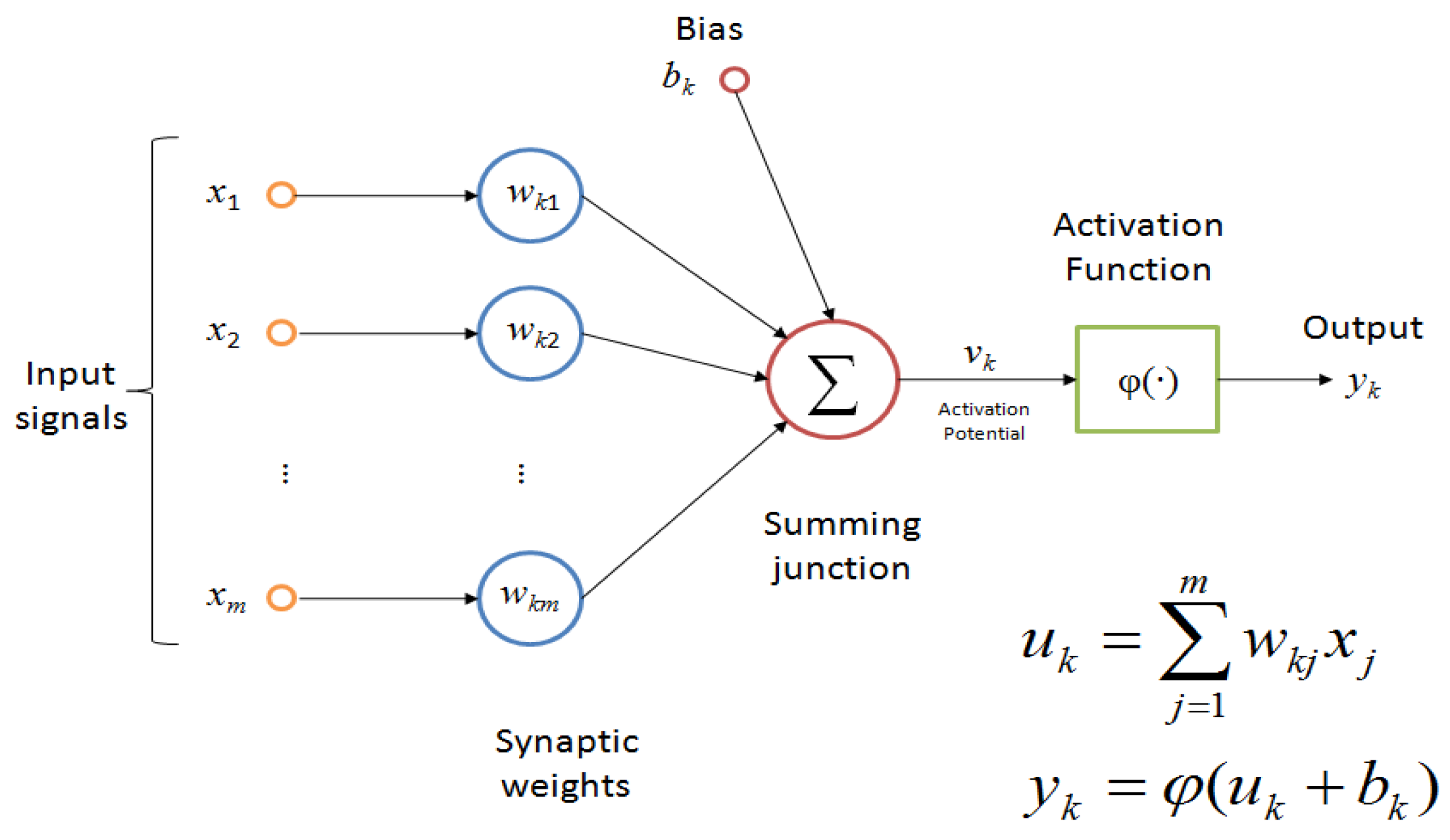
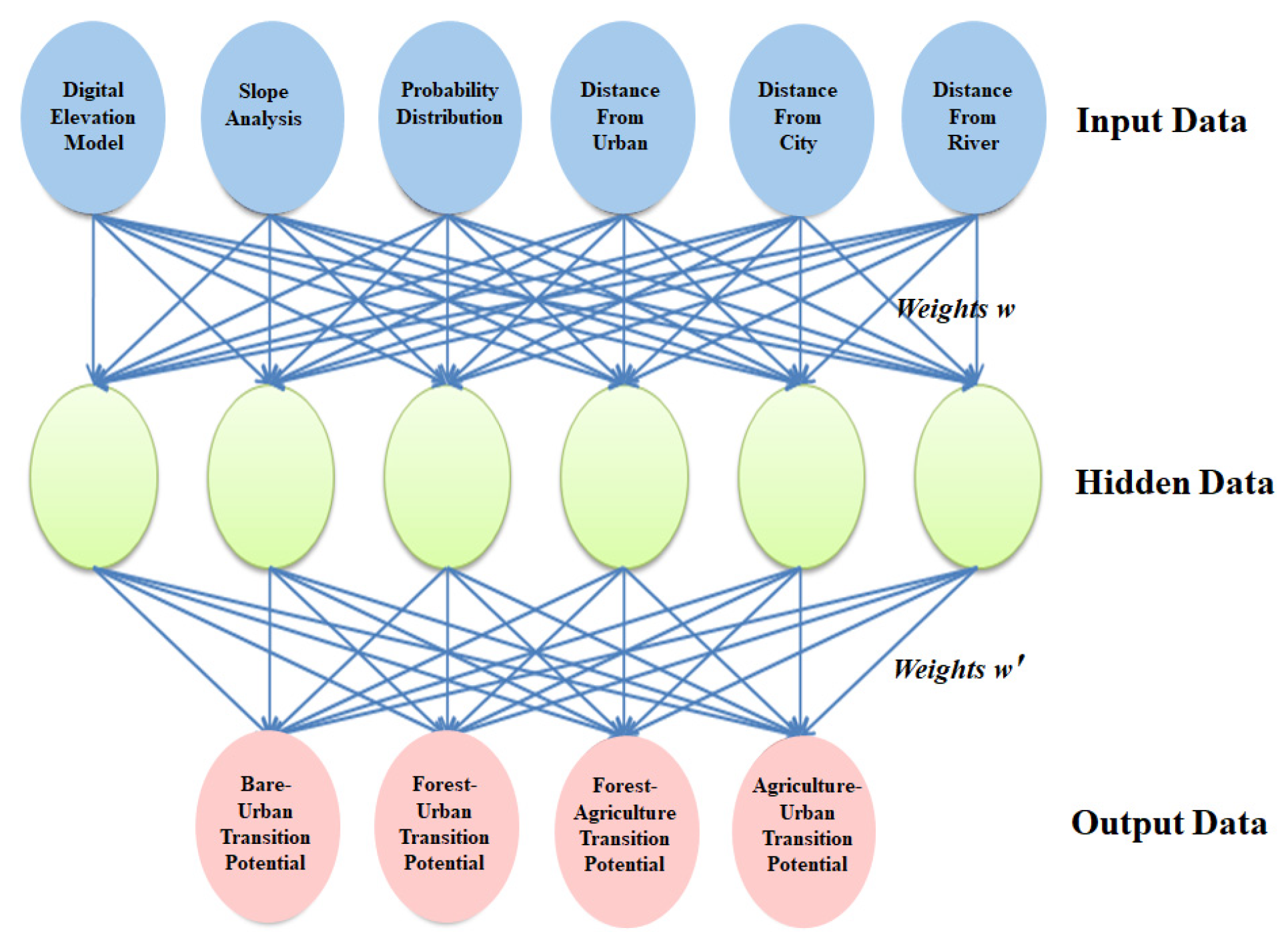


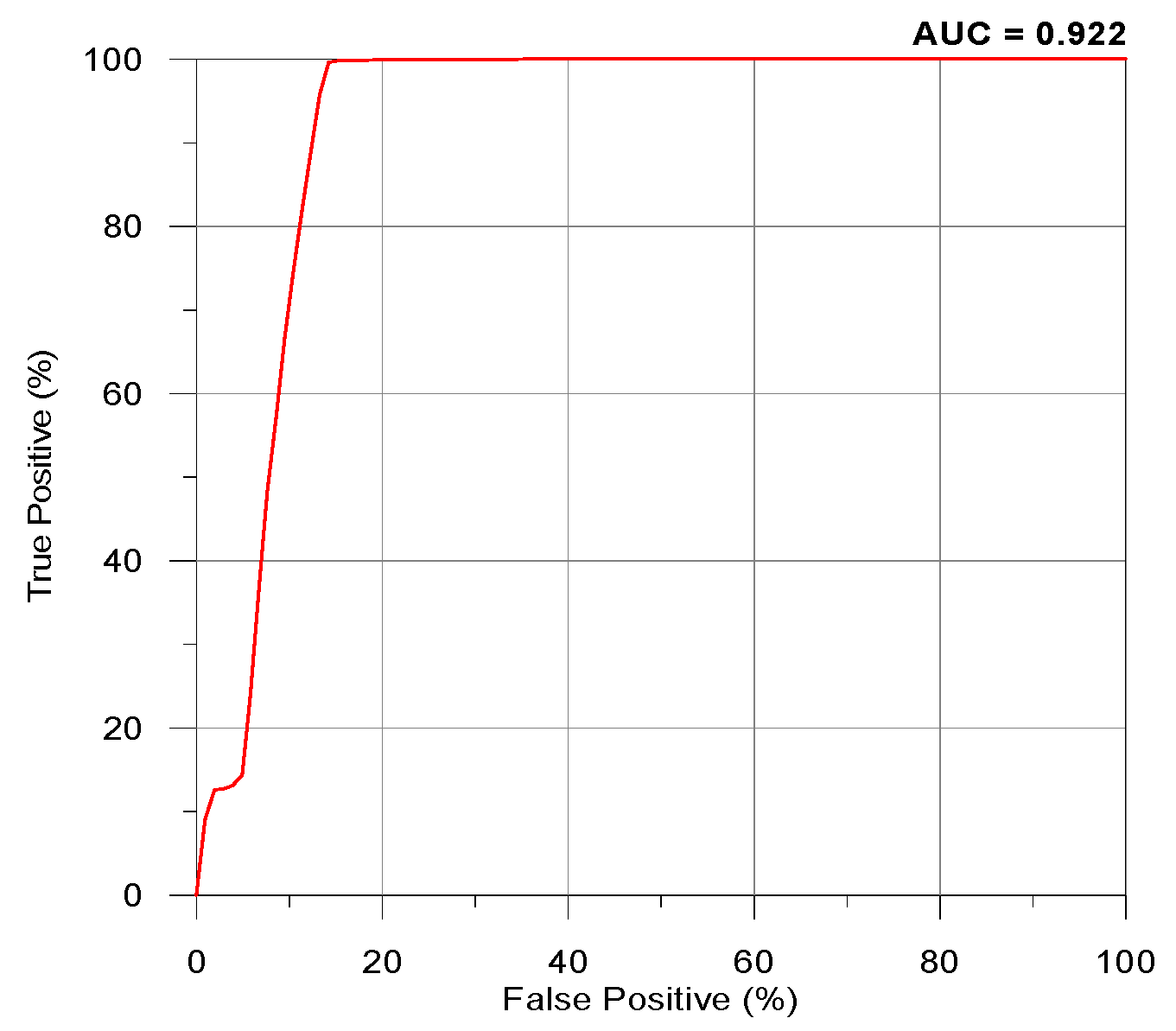
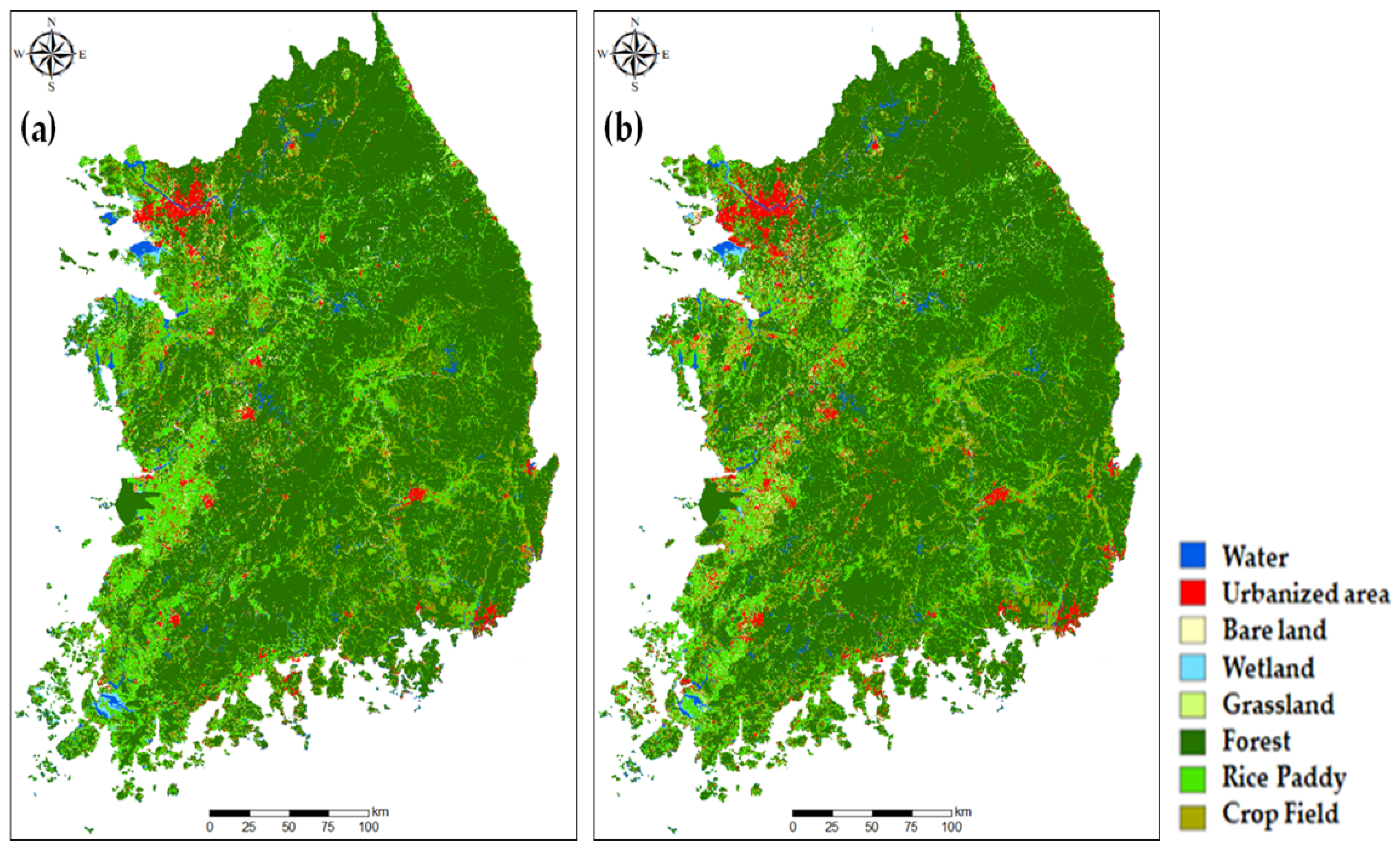
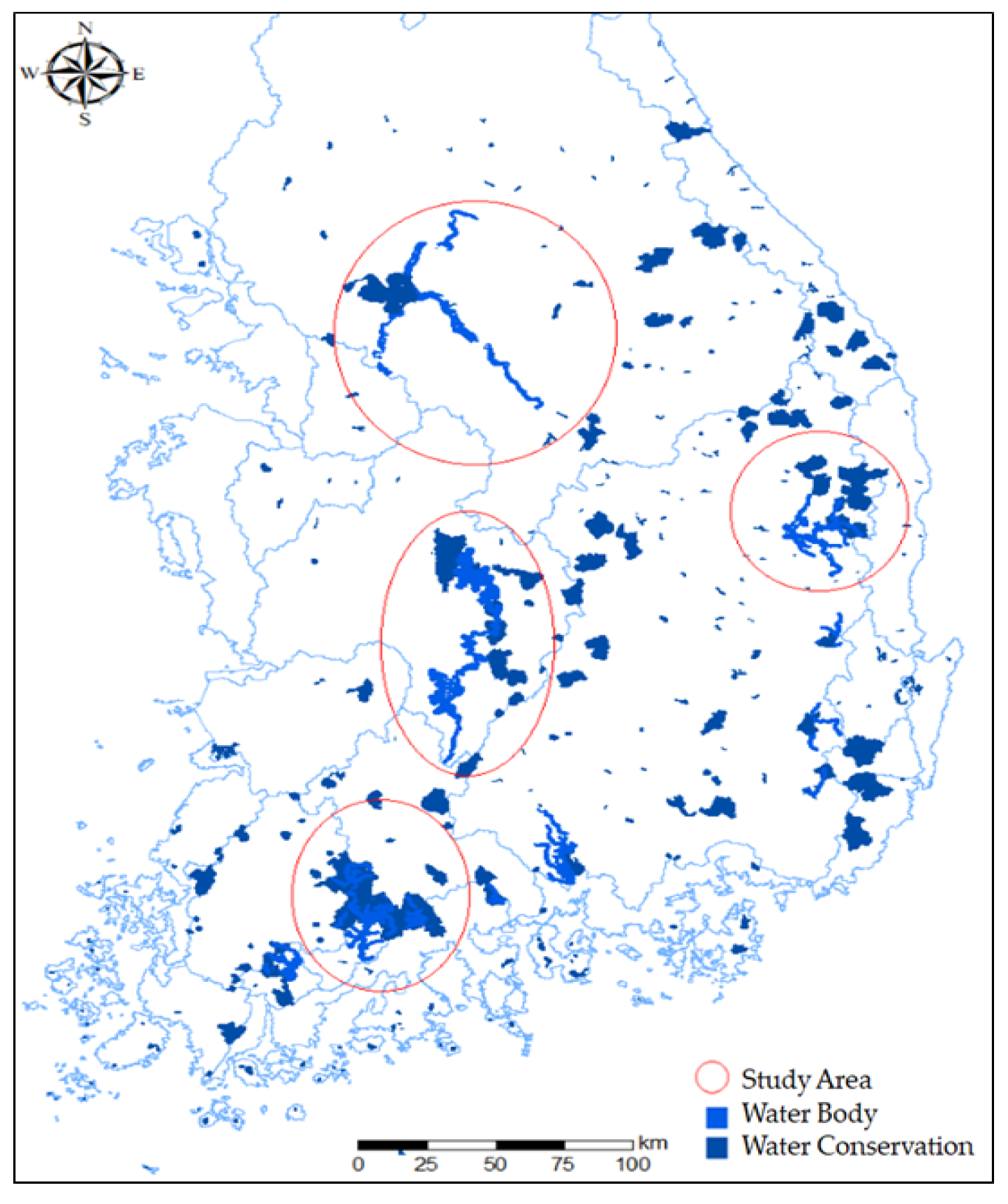
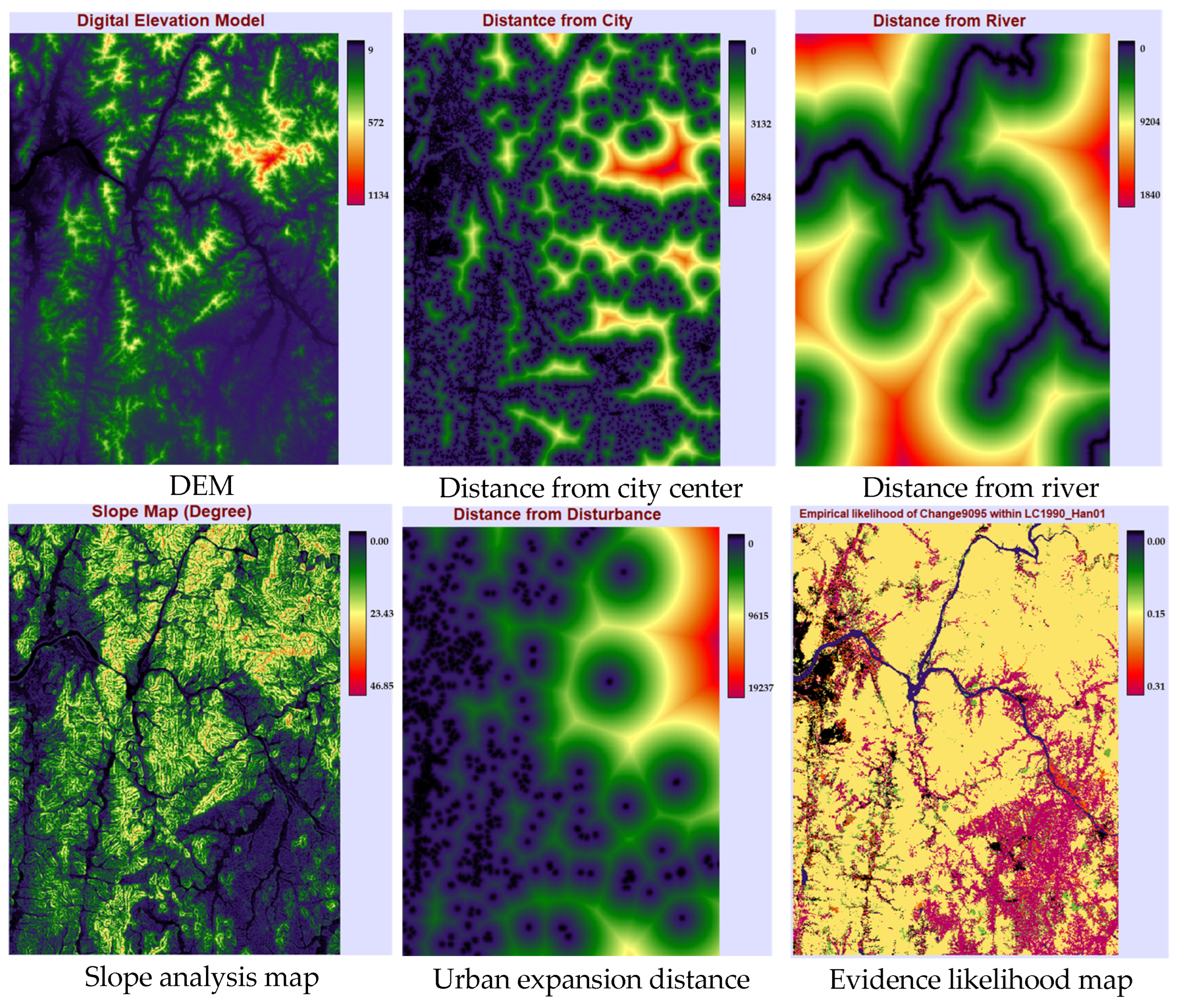
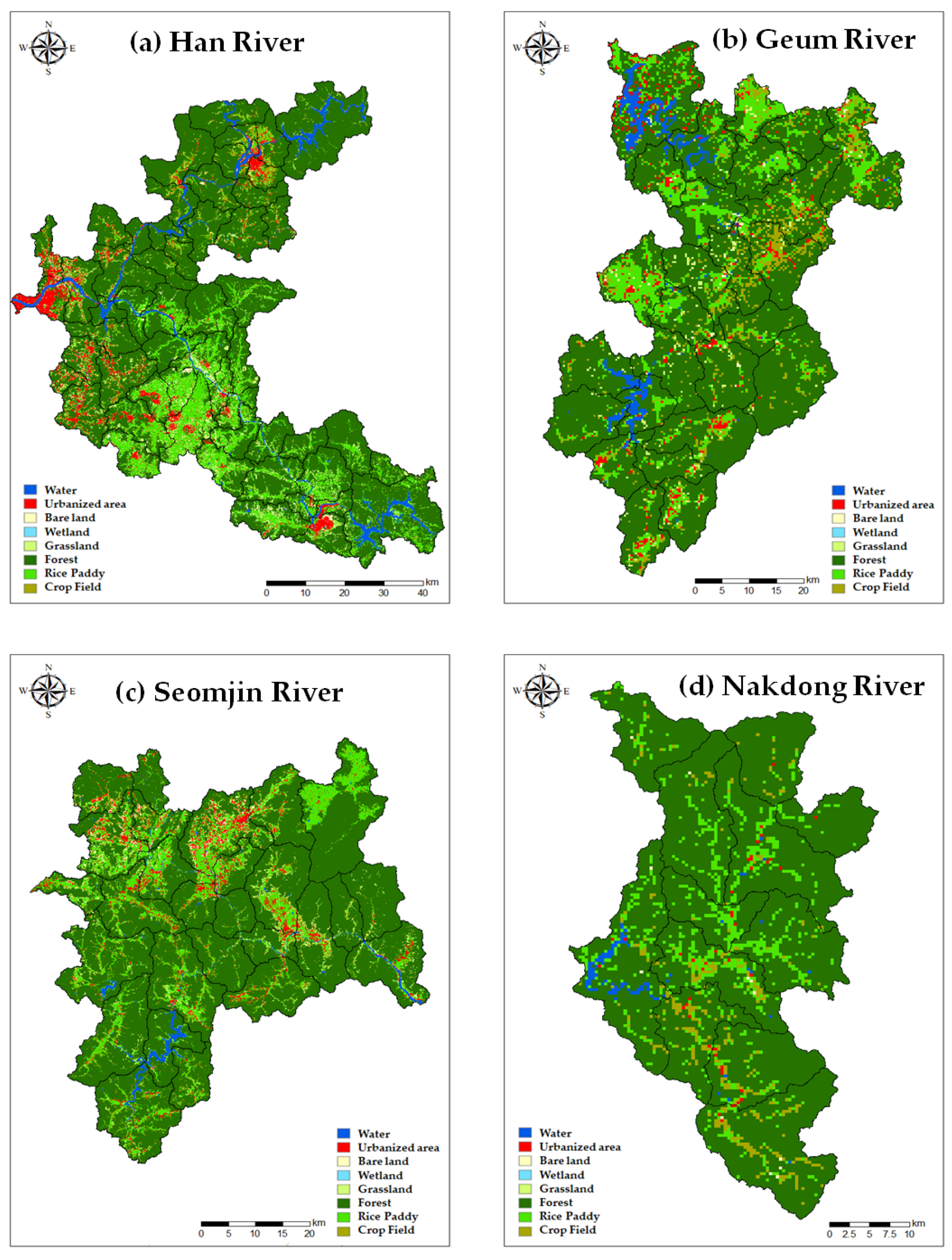
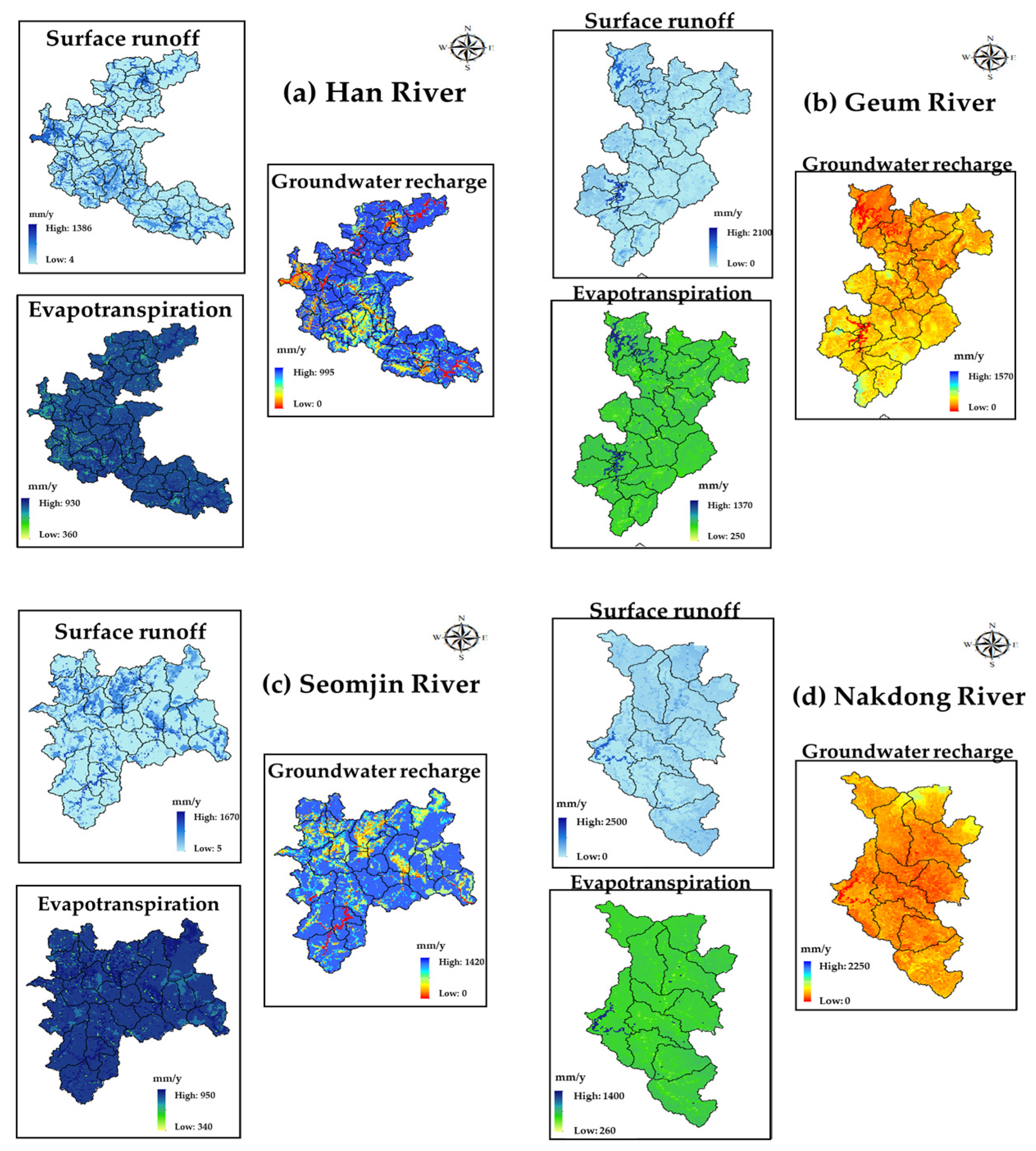
| Name (Classification Code) | Notes |
|---|---|
| Habitation/construction area (100) | Buildings such as residential, commercial, industrial, and transportation facilities |
| Agricultural area (200) | Agricultural areas such as rice paddies and fields, fruit trees and street trees, livestock/dairy facilities |
| Forest area (300) | Land-growing trees in clusters |
| Vegetative area (400) | Land covered with vegetation (both natural and anthropogenic) |
| Wetlands (500) | Wetlands where the moisture is maintained by natural environments |
| Bare soil (600) | Bare land without any vegetation cover |
| Water bodies (700) | Low areas of standing water, such as lakes, reservoirs, swamps |
Disclaimer/Publisher’s Note: The statements, opinions and data contained in all publications are solely those of the individual author(s) and contributor(s) and not of MDPI and/or the editor(s). MDPI and/or the editor(s) disclaim responsibility for any injury to people or property resulting from any ideas, methods, instructions or products referred to in the content. |
© 2024 by the authors. Licensee MDPI, Basel, Switzerland. This article is an open access article distributed under the terms and conditions of the Creative Commons Attribution (CC BY) license (https://creativecommons.org/licenses/by/4.0/).
Share and Cite
Heo, J.; Lee, J.; Hyun, Y.; Park, J. Integrating Machine Learning, Land Cover, and Hydrological Modeling to Contribute Parameters for Climate Impacts on Water Resource Management. Sustainability 2024, 16, 8805. https://doi.org/10.3390/su16208805
Heo J, Lee J, Hyun Y, Park J. Integrating Machine Learning, Land Cover, and Hydrological Modeling to Contribute Parameters for Climate Impacts on Water Resource Management. Sustainability. 2024; 16(20):8805. https://doi.org/10.3390/su16208805
Chicago/Turabian StyleHeo, Joonghyeok, Jeongho Lee, Yunjung Hyun, and Joonkyu Park. 2024. "Integrating Machine Learning, Land Cover, and Hydrological Modeling to Contribute Parameters for Climate Impacts on Water Resource Management" Sustainability 16, no. 20: 8805. https://doi.org/10.3390/su16208805
APA StyleHeo, J., Lee, J., Hyun, Y., & Park, J. (2024). Integrating Machine Learning, Land Cover, and Hydrological Modeling to Contribute Parameters for Climate Impacts on Water Resource Management. Sustainability, 16(20), 8805. https://doi.org/10.3390/su16208805







